In recent years, unicycling has blossomed into a large variety of distinct types of riding, with a type to satisfy almost any interest. This has spurred the development of many specialized unicycles, optimized for each type of riding. The descriptions, below, cover the main types of unicycle and the types of riding to which they are suited.
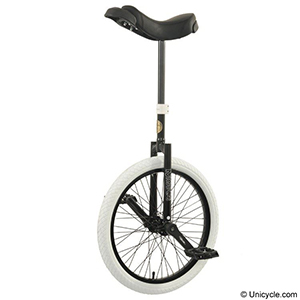
Unicycle competitions have given rise to a style of riding called artistic freestyle. This is a type of riding where individual or group performance routines are set to music, somewhat like gymnastics or ice skating. The typical freestyle unicycle has a 20” wheel with a medium-width, smooth tire. Some freestyle techniques depend on having flat tops to the forks, where you can place your foot. Many freestyle unicyclists prefer to ride with short cranks (100mm or less). Freestyle unicycles also get used for other indoor unicycling activities, such as hockey and basketball.
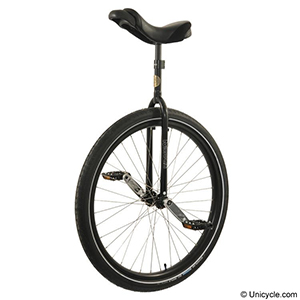
For riding outdoors on the street, you can use a 20” freestyle unicycle, or you can use a unicycle with a somewhat larger wheel, say, 24” to 29”. The larger the wheel, the faster and farther you can ride. Beginners will find it easiest to start on a unicycle with a 20” to 24” wheel. Smaller children may need to start on a 16” wheel.
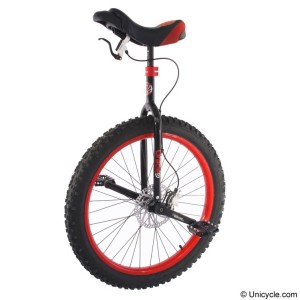
The unicycling equivalent of mountain biking is muni (mountain unicycle) riding. A typical municycle has a 24”, 26”, or 29” wheel with a very fat, knobby tire. Some riders use a brake, with a brake lever located under the front of the seat. Muni riders usually prefer long cranks which provide additional leverage on steep terrain and metal pedals which are more durable and hold to the feet on the pedals better. Occasionally, geared hubs are also used.
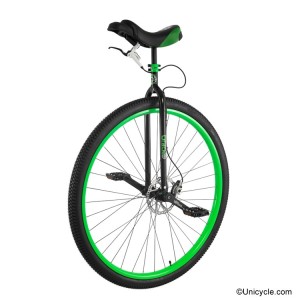
Long-distance unicycling has been popular since the Coker company introduced a very large wheel unicycle in 1998. Some riders are traveling as far as 100 miles in a day on unicycles. It is also possible to ride long distances on a unicycle with a smaller wheel, if it has a geared hub. A typical long-distance unicycle has a 36” wheel with a large tire. Often, it has small handles that project from the front of the seat to allow you to stand up or adjust how you are sitting. A beginner usually starts with very long cranks (152mm), but more experienced riders prefer shorter cranks. Cranks may also be changed, depending on how hilly the day’s ride will be. Some riders use a brake, with the brake lever mounted on the handles or under the front of the seat.
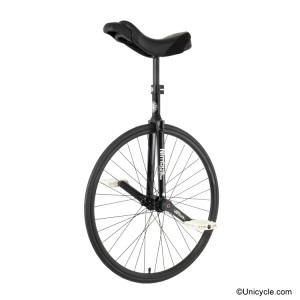
US and international competition have settled on a standard unicycle for certain track and road races. This unicycle has a 24” wheel and 125mm cranks (younger riders use a 20” wheel with 100mm cranks). A unicycle optimized for racing might have a very skinny, smooth tire and a lightweight rim and frame.
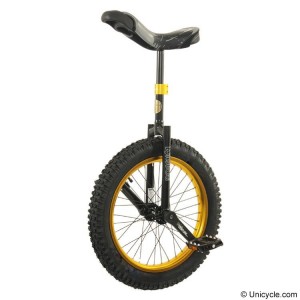
Trials and Street riding are the unicycle equivalents of bicycle trials riding or skateboarding. In trials riding, you negotiate extreme obstacles and jump large distances. Street riding makes use of urban obstacles, such as stairs, railings, walls, park benches, etc. Both types of riding use a unicycle with a 19” wheel and a very fat, knobby tire. Usually, the seat is set quite low. Trials and street unicycles must be very strong in every way. Even so, advanced riders break equipment regularly. If you want to get into trials or street riding, make sure you buy a unicycle intended for that purpose, along with the proper safety gear.
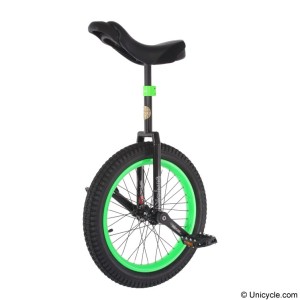
Flatland is like Street riding, but it doesn’t use any obstacles. Oftentimes flatland riders use a Trials/Street unicycle, but some riders prefer a 20” wheel with a somewhat smaller, smooth tire. Flatland riders may also use shorter cranks than a trials rider would.
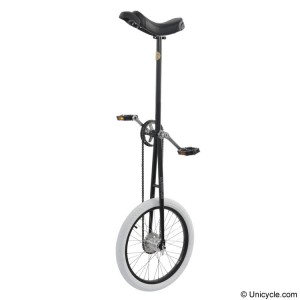
A giraffe unicycle is a tall (usually 4’ to 8’) unicycle which is often used in parade routines. Giraffes typically have a 20” wheel and use a chain to connect the pedals and cranks to the wheel. Although it can be intimidating to be perched so high, riding a giraffe is surprisingly similar to riding an equivalent shorter unicycle.